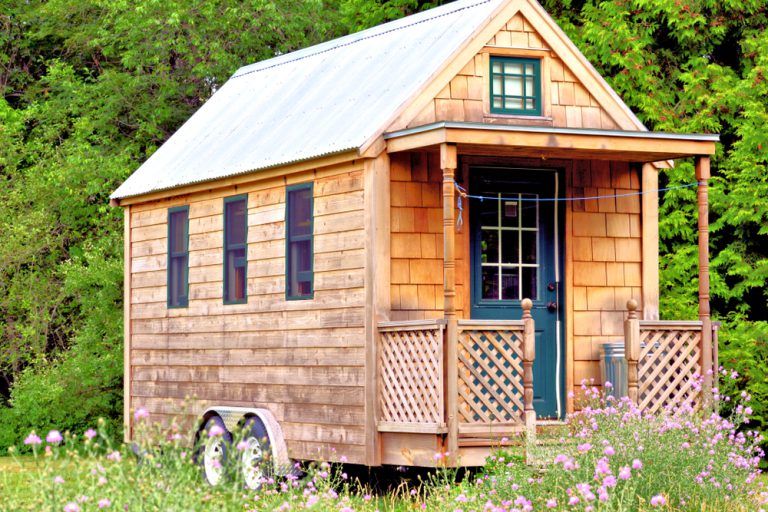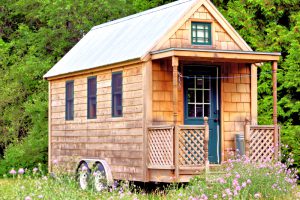
 The tiny house movement has taken the world by storm. Everywhere you turn, there’s a new tiny house hotel popping up or another TV show about people building (or buying) their miniature dream homes.
The tiny house movement has taken the world by storm. Everywhere you turn, there’s a new tiny house hotel popping up or another TV show about people building (or buying) their miniature dream homes.
But what’s it really like to live in a tiny house? And what about those tiny travel homes built onto wheels — what makes it a better travel option than an RV or camper?
As popular as this new lifestyle may be, it’s not without its misconceptions and confusions, especially when it comes to the traveling versions of these teeny-tiny homes.
In this post, we’ll lay out everything you need to know about the actual experience of living in a tiny house, whether you’re opting for one on wheels or just looking for a small space to stake your claim on a permanent basis.
What is a Tiny House?
Let’s start from the top. What, exactly, *is* a tiny house, anyway? There are lots of small structures out there — so which ones qualify?
While there’s no definitive set of specific metrics, most tiny homes are residential structures of about 400 square feet or less, though some tiny homes do measure slightly larger. (By way of comparison, a 40-foot fifth wheel travel trailer with multiple slide outs can offer up to 500 square feet of living space, which can feel pretty darn big by “tiny” standards!)
The Tiny House movement has some historical tendrils dating back as far as the 1960s — or even back to the days of our cave-dwelling ancestors, if you want to get really technical about it. But the movement as we know it today, which is focused on intentional, minimalistic living, really gained momentum in the 1980s and 90s, and has skyrocketed in popularity in the 2010s.
Tiny houses come in a broad range of types and styles, and since many are custom designed by their owners, you’ll find quite a few that are totally unique and unlike any other tiny house in the world. Some tiny houses are built on foundations, but it’s also common for tiny houses to be built for off-grid living — that is, to be fully self-reliant, using tools like composting toilets to keep them functional even without hooking up to city plumbing or sewer systems.
Off-grid tiny houses are commonly built onto trailer platforms, which means they exist on wheels — which, of course, makes it a whole lot easier to pick up and move them for traveling purposes. However, although many people think tiny traveling homes are just prettier travel trailers, it’s not actually that simple! Read on to learn more about the differences between these two types of travel-focused accommodation options.
Traveling Tiny House

The tiny house movement is, for many who take it on, rooted in a kind of minimalism. Instead of spending all their money on a big house (and the many expenses such structures generate), tiny house dwellers are more focused on keeping only the objects that truly matter to them, so they can save time, money, and headspace for the stuff they really want to bring into their lives. And in many cases, one of those things is travel — or, more specifically, the unique experiences with new places and people that only travel can provide.
If you’re wanting to lead a full-time travel lifestyle, living in a tiny house on wheels can seem like the perfect solution. You get all the comfort and style of a “real” house coupled with the mobility and convenience of a travel trailer — or at least, so it seems, given the endless Instagram and Pinterest rabbit holes of perfectly-HGTV-looking tiny homes on wheels, parked in ever more picturesque places.
But the truth is, tiny houses aren’t built to move in the same way travel trailers are — even those built on wheels. Because they generally utilize traditional construction materials and practices designed with permanently-placed homes in mind, tiny homes can suffer damage when they’re exposed to the stress and friction of road travel, and even require extended maintenance after every trip. Of course, motorhomes and travel trailers are also well-known for their maintenance requirements… but because they’re built specifically for motion, most of their parts can withstand a lot more moving and shaking than a tiny home can.
It’s also important to understand that tiny homes exist in a kind of gray area from a legal standpoint. Many cities have specific building codes in place meant to help keep people from creating or living in structures that are unsafe. However, these codes can end up causing problems because of arbitrary “safety” standards like square footage minimums, which could make a tiny house illegal to live in; some cities may require that any residential domicile is built into a solid foundation, rather than being on wheels.
Depending on where you are, these rules may or may not actually be enforced — especially if you can situate your tiny house on private property, for example, in someone’s backyard. In that kind of scenario, you’re unlikely to run into any trouble unless you specifically annoy someone or step on someone’s toes, but if you’re going to take on this lifestyle, you should understand that you may be breaking the law simply by sleeping in your own bed each night. (Which, we’ll be honest, sounds kind of cool.)
Tiny House, Camper Trailer — or Both?

Another way to go about the tiny house travel trailer life is to park your rig in RV campgrounds, which are always legal places to camp. If your tiny home is set up to use a water and electric hookup like an RV is, this option is even more appealing; you’ll be able to enjoy all the comforts of home — literally — without having to worry about setting up for solar or using a composting toilet.
Speaking of camper trailers… if the tiny house movement appeals to you, you may also want to seriously consider trying out the RV lifestyle instead, particularly if you’re planning on doing a lot of traveling. As mentioned above, even tiny houses that are built on wheels aren’t really well-suited to constant trips, but are rather a good option for those who mostly want to live stationary lives but occasionally pick up and move, perhaps on a seasonal basis.
If you want a new view out of your windshield every few weeks or so, however, RVing might make more sense for a full-time solution for you. And although they don’t have the same uber-cute form factor as most tiny houses do, RVs are still functional, attractive, and stylish… not to mention available in a huge range of types, footprints, and price points, so you’re sure to find a solution that will work for you.
From luxurious Class A diesel pushers or generously-sized fifth wheels to modest pop-up trailers and sleeper vans, the best type of RV for your full-timing adventure will depend on your personal travel activities and preferences. For more information on the different types of RVs on the market and some full-timer inspiration, check out the following RVshare posts:
- A Deep Dive Into RV Types + Figuring Out Which is Right For You
- A Deep Dive into Class A Motorhomes
- Little, but Powerful: A Deep Dive into Class B Motorhomes
- Deep Dive into Class C Motorhomes
- A Deep Dive into Travel Trailers
- A Deep Dive into Toy Haulers
- A Deep Dive into Fifth Wheelers
- A Deep Dive into Pop-Up Campers
- Ready to Hit the Road? 7 Full Time RVing Must-Haves
- Can you Afford to RV Full Time? Consider This
- RV Living Inspo: Full Timer YouTube Channels
Can You Have a Two Story Tiny House?
If there’s one area tiny houses *do* beat RVs in, it’s customizability. Since you design the tiny house yourself from scratch, you can have pretty much whatever you want — and yes, two-story tiny homes and lofted options are popular.
But if you’re looking for an accessible and relatively affordable way to get on the road as soon as possible and maintain a nomadic lifestyle, RVs will win over tiny homes every single time.
Looking to experience the RV life for yourself? renting a rig through the peer-to-peer network is a great way to get a solid understanding of exactly what this travel lifestyle is like. Our trusted local owners offer rigs of every shape, size, and footprint, so you’ll get to learn more about which type of camper works best for your travel goals. (Not to mention the fact that it’s just plain old fun, to boot!)
This post may contain affiliate links.
